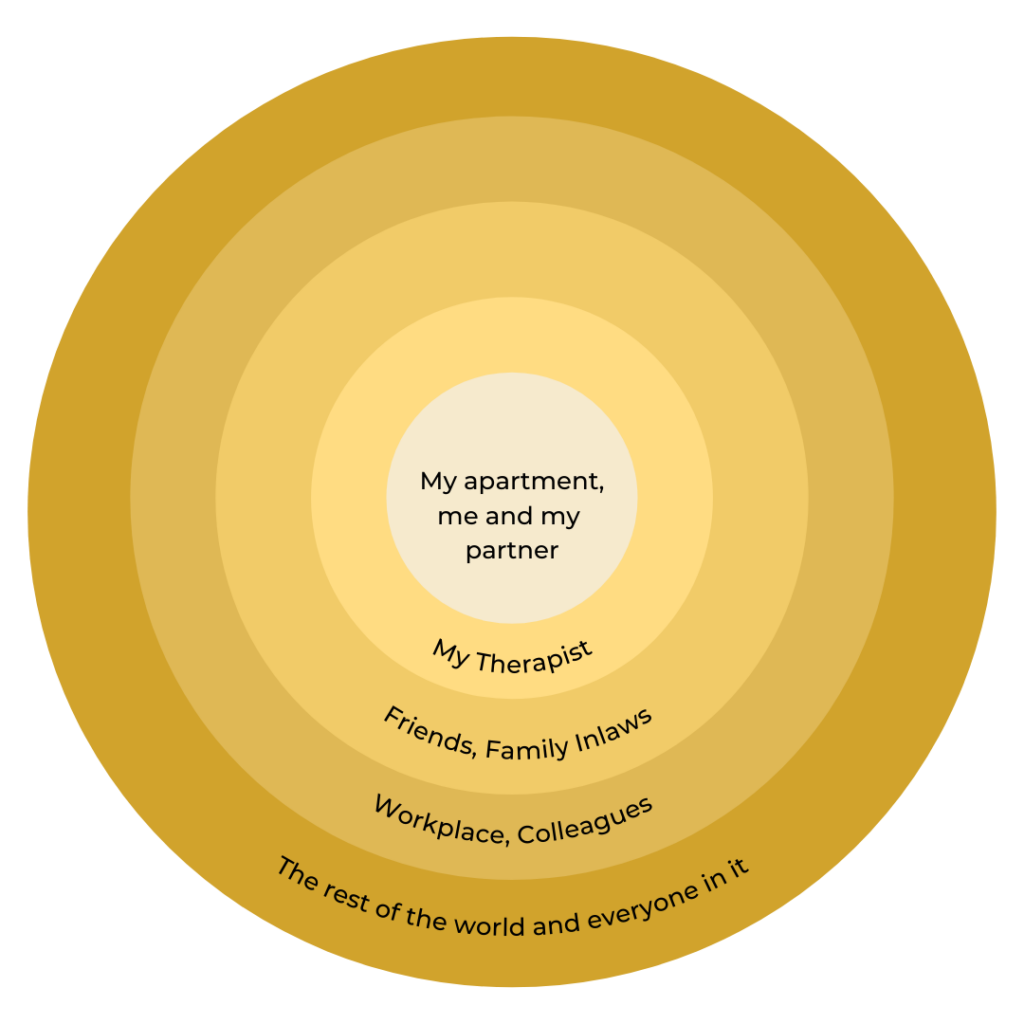As a child with alopecia, I felt I had to be ready for anything. Reflecting on my childhood and my young adulthood, I can recognize now the ever ready state I was in. First when I was outside the safety of my home after starting school, and then outside of school after graduation and into the “real world”.
Never knowing who was going to stare at me, point a finger, tell me they were praying for me or ask me why I had no hair. Younger than that it was who was going to call me a boy, tell me I was in the wrong bathroom, give me a thumbs up or a high five for beating cancer. *
I wouldn’t call it constant vigilance, but there were places I was able to rest from thinking about who was going to say something unexpected…. and places I wasn’t.
I’ve already written about being called an alien when I was very young. About the badge I was given for being a ‘kid with cancer’. I’ve mentioned in passing the people who touched my head without invitation and the hairdresser who thought I’d ‘lost my crowning glory’.
It’s not surprising that I’ve built up wall after wall of defenses so that when people do react or I’m put on the spot – I can deal with it without flinching. The walls may have changed over the years – for example from letting people touch my head to feeling empowered enough to say no. But the walls are still there.
I don’t think this is isolated to people who look different either. Considering something like 60% of American Adults experienced some form of childhood trauma, I imagine this is pretty common.
I sometimes wonder if we really know what safety is. Amongst these walls, defenses, and automatic responses – I think we sometimes get lost or confused about what it means to be safe.
Circles of Safety
We can easily look at our lives and group the spaces and people we spend the most time in and with – in order of safety. It may look like:
For most of us, we can look at our lives and easily group the spaces and people we spend the most time with and then order them by where we think (and feel) might be the safest. It may look like this – concentric circles with the innermost circle your home and partner/s (safe as houses), to the scary wide world and everything in it.

Alternatively you may have layers upon layers between. Maybe work isn’t a safe place for you, perhaps your boss is retaliating for something, or is biased. Maybe your closest friend is your beloved dog, or you don’t have a therapist.
Whatever your circles are, they can help you understand what you describe, or feel, as safe.
There’s more to it though. Feeling safe in our bodies can be different, or even exist outside of those places and people we identify as our safe spaces. If you have your physical safe spaces defined (people and places) I invite you to explore how your body tells you you’re safe? What textures and sensations stand out to you?
How I discovered my sense of safety
When my sister passed away, I thought I’d never feel safe again. I was scared everyone in my life would now die. I was confronting my own mortality, the mortality of my loved ones and the reality that everything ends.
I couldn’t deal with it. I did everything to push it away, numb myself out and I admit I was lost. I didn’t show up for my family at that time at all, and I really didn’t show up for myself in the way I wish I could have.
I didn’t have the toolset or skills to deal with it.
What it did change for me, was my concept of safety. Before this experience, and in the aftermath, safety never really crossed my mind. Of course I knew not to walk alone at night in an empty car park, I knew I had to watch out for strange men. I was still hyper aware of those around me and what they might say about my bald head – but FEELING SAFE? What was that?
As part of my embodiment training, a very good friend and colleague did a Pleasure practice with me. The target of this practice is to find and expand any pleasure in your body.
I scoffed at the idea, pleasure is not something I’d had time for in the last 5 or so years, maybe more. Aren’t we all too busy “adulting”? Who makes time for pleasure? I was in for a surprise.
As she guided me through this practice, I first started feeling completely overwhelmed by my sadness, grief and loss. This was very common for me in my first few months of learning these new ideas and practices. However, this amazing colleague guided me back to safety alongside these intense emotions and despite them coming up – I could feel this resource of safety in my body.
It felt like deep relaxation, heaviness in my thighs and where my body made contact with the chair, My shoulders dropped and my jaw released. As we focused on that safety, expanding it allowing it to take up space – I felt this slight spark of joy. The tiniest bit expanded and I realized that was my entry point to pleasure.
For those of us who have experienced deep traumatic experiences, it is so important to seek support and assistance. I was in talk and movement therapy at this point. Ensuring access to and utilizing this support network provided a strong base to explore embodiment and really helped me get in touch with internal felt spaces that I hadn’t dared explore before on my own. Most of us tend to avoid feelings and sensations that are emotionally or physically painful.
As I continued to work with this entry point to safety, I began to develop a deep understanding and concept of what my body feels like when it’s safe.
This became my basis for all my embodiment work moving forward. It’s now the basis for my movement practice, for my meditation, for my dancing, for my writing and for my work with my amazing new therapist.
Finding this somatic safety in my body has opened the door to deeper and deeper depth within myself, and uncovering who I am.
How it applies to hair loss and alopecia
As those experiencing hair loss, we see this reflected around in those who share our journey. Beautiful amazing people who have lost their hair and are being honest and authentic about its impact. We use words like ugly, lost, frustrated. We say we no longer feel sexy, lovable, comfortable. We no longer feel like ourselves.
These may not be words we say to our loved ones or friends. In some cases, they are only words we say to ourselves. We alone are hearing them. We alone become that “safe place” to speak these words – that center circle all by ourselves.
But it’s not safe, and these are not safe words. And so they betray the sense of safety that we conceptually believe exists. Some spaces, places and people no longer feel safe.
This may then get coupled with external experiences – people saying something, feeling insecure about our wig or hat on a windy day, scrambling to cover our head when there’s a package delivery. For bald womxn and those living with some physical differences, it can feel like we never know what will be thrown at us day to day. For some of us, even a smile from a stranger can set our heart, mind and emotions spinning.
I know. I’ve been there.
This is where developing and cultivating a deep sense of somatic safety within your own body can be invaluable.
And it’s doable. It is so doable.
* A friend recently asked why I take such offense at being asked if I’m “going through treatment” or if I have cancer. I want to clarify, it’s not the fact that it’s cancer. As an adult when this happens, I’m more inclined to correct them and show some compassion as most of the time those who bring this up are looking for someone to identify with them on their journey – or experiences with a loved one. There is nothing wrong with that.
The whole exchange though can be embarrassing (for both parties) and frustrating. Approaching anyone and commenting openly about their body is presumptuous and generally speaking is invasive. This is the part of the interaction that I have had to learn how to deal with. It’s also the part I like to educate others on, whether it’s how to deal with it, or why it’s problematic (for those who don’t understand).
